
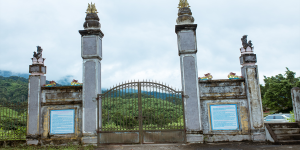
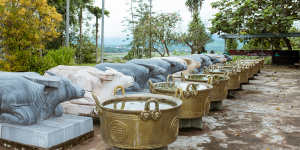

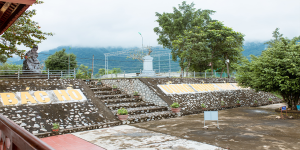
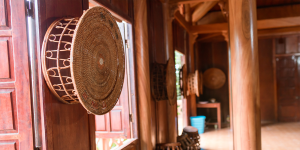
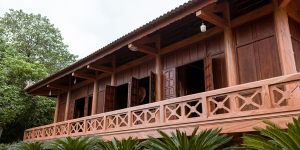

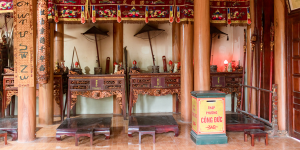
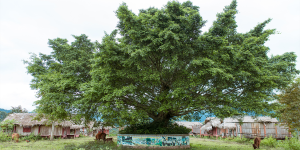
Camera tour
Price: Free
Time to visit a place: 120 phút
Open Time: 7:00 AM - Close Time: 6:00 PM
Address: Chau Kim Village, Que Phong District, Nghe An Province
CHIN GIAN TEMPLE TOURIST SITE
Located more than 170km west of Vinh city, in the territory of Chau Kim commune, Que Phong district, Chin Gian temple is famous as a sacred temple, associated with many legends about the birth history of the village, establishment of Muong of Thai ethnic group, is also an attractive spiritual and cultural tourist destination for tourists from all over the country when visiting the West of Nghe An province.
Chin Gian temple - Thai language called Ten Cau Hong, was built to worship Then Pha (Heaven's King), Nang Xi Da (God's daughter), in addition, it also worships Tao Lo Y, Cam Lu, and Cam Lan - who contributed to the founding of village and hamlet. According to historical documents and folk legends, Chin Gian temple was built in the mid-14th century, associated with the great migration of the Thai ethnic group from the North to Nghe An province to live. At this time, the Cam family clan took turns to be the leader of the Thai people both in terms of kingship and theocracy, historically known as the Chau Hoa regime. This is the period that all first 9 hamlets of the Thai people are very prosperous and happy... At first, the temple was only made of thatch, bamboo and cork, later, it was rebuilt with wood in the style of stilt houses of the Thai ethnic group on a hill which was called as Pu Pom. With the terrain: in front is the cool green Nam Giai river, behind is the gentle Kim Khe hamlet, around is covered with ancient forest trees, giving the temple a poetic, warm and sacred beauty.
Not only located on a beautiful and charming terrain, the works of Chin Gian temple are also arranged according to the spiritual axis, including: buffalo bathing beach, Tho Than small temple, Nghi small temple, buffalo donation column, courtyard with 09 stone buffaloes, 09 large cauldrons and temple area - the central work of the monument, giving visitors a feeling of sacredness and mystery. The temple is made in the style of stilt house architecture, typical of the Thai ethnic group, with an area of 138.6m2, around house made of planks, in front and on both sides, there are many door systems that both serve as walkways and as a way to get light. Outside the corridor is a wooden railing system, made in the style of bars, turning to form rows of "harrow teeth" in Thai language called "phát ban", around decorated with patterns, mainly rosette and lemon flowers. On both sides of the entrance, there are 2 stairs going up and down with 9 steps. The sacred space of the temple is concentrated in 09 altars of 09 hamlets. The arrangement of worship is followed the strict convention of the Thai ethnic group, taking each row of columns in the truss to divide the altar spaces. The main and solemn position of the temple is located in the middle (Muong Ton) which is the place to worship Then Pha, Nang Xi Da and Tao Lo Y. The remaining compartments are the place of worship of 08 hamlets. On the altars are placed worshiping objects associated with religious customs of the Thai ethnic group such as bamboo tubes, umbrellas made from brocade cloth with bamboo handles. According to the concept of Thai people, the umbrella is for the gods to cover the rain and sun when they return to heaven, and the bamboo tube holds water for the gods to carry and drink when thirsty. In addition, some other essential worship items are also placed to serve the spiritual rituals of the temple.
In 2008, Chin Gian temple relic was ranked as a provincial historical relic. By 2016, Chin Gian temple festival was included in the list of national intangible cultural heritage by Ministry of Culture, Sports and Tourism.
Distance: 4.49 km
Distance: 4.67 km
Distance: 4.98 km
Distance: 5.31 km
Distance: 5.50 km
Distance: 5.75 km
Distance: 6.08 km
Distance: 9.81 km
Distance: 10.47 km
Distance: 11.06 km
Distance: 11.14 km
Distance: 11.22 km
Distance: 11.35 km
Distance: 4.04 km
Distance: 5.68 km
Distance: 6.26 km
Distance: 0 m
Distance: 10 m
Distance: 3.42 km
Distance: 9.96 km
Distance: 11.35 km
Distance: 13.40 km
Distance: 18.28 km
Distance: 2.42 km
Distance: 2.48 km



0
No Comment!